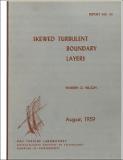Skewed turbulent boundary layers
Author(s)
Nelson, Warren G. (Warren George)
Download09162430.pdf (2.446Mb)
Other Contributors
Massachusetts Institute of Technology. Gas Turbine Laboratory
Metadata
Show full item recordAbstract
The problem of predicting the growth of incompressible, skewed, turbulent boundary layers on smooth surfaces is considered. It is supposed that sufficient initial information and a complete knowledge of the external pressure distribution is given. A computation scheme is devised which makes use of the two momentum integral relations and an auxiliary equation. The formulation of the latter is based on the empirical observation that if a velocity profile is plotted in a holograph plane the outer portion is nearly always linear. A theoretical means of describing velocity distributions is formulated. These theoretical profiles contain two "universal"- functions and five parameters that are functions of the surface coordinates only. The "universal" functions are derived analytically and. compared with experiment. Finally, a comparison of theoretical and experimental velocity profiles suggests that the proposed computation scheme is only applicable to situations where gradients of flow quantities in the cross-flow direction are not too large. Therefore, the scheme is probably better suited to the external flow over wings, etc., than to flows in turbomachinery.
Description
August 1959 Includes bibliographical references (pages [48]-[49])
Date issued
1959Publisher
Cambridge, Mass. : Gas Turbine Laboratory, Massachusetts Institute of Technology, [1959]
Series/Report no.
GTL report #55